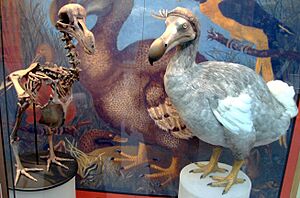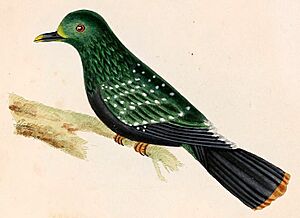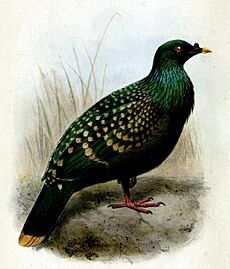Spotted green pigeon facts for kids
Quick facts for kids Spotted green pigeon |
|
|---|---|
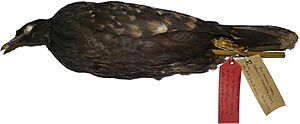 |
|
| The only specimen in existence today | |
| Conservation status | |
| Scientific classification | |
| Genus: |
Caloenas
|
| Species: |
maculata
|
| Synonyms | |
|
|
The spotted green pigeon or Liverpool pigeon (Caloenas maculata) was a type of pigeon that is now most likely extinct. It was first described in 1783 by John Latham. He had seen two birds and a drawing of one. For a long time, scientists weren't sure how this bird was related to others. But many thought it was similar to the Nicobar pigeon (C. nicobarica). So, it was placed in the same genus, Caloenas.
Today, we only know about this bird from one specimen. It is kept safe in the World Museum, Liverpool. For most of the 1900s, people didn't pay much attention to it. But in 2008, the IUCN Red List officially recognized it as a real, extinct species. This pigeon might have lived on an island in the South Pacific Ocean or the Indian Ocean. Some people think it might be the bird that Tahitian islanders called titi. In 2014, a study of its genes confirmed it was a unique species. It is indeed related to the Nicobar pigeon. The study also showed that these two pigeons were the closest relatives of the extinct dodo and Rodrigues solitaire.
The only surviving specimen is about 32 cm (13 in) long. It has very dark, brownish plumage (feathers) with a green shine. The feathers on its neck are long. Most feathers on its back and wings have a yellowish spot at their tips. It has a black bill with a yellow tip. The end of its tail has a pale band. This pigeon had fairly short legs and long wings. Some people thought it had a bump on its bill, but there is no proof of this. The Nicobar pigeon mostly lives on the ground. But the spotted green pigeon's body suggests it lived mostly in trees. It probably ate fruits. The spotted green pigeon might have been close to disappearing when Europeans first arrived in its home. It may have vanished around the 1820s because of too much hunting. Also, new animals brought by humans might have eaten them.
Contents
Discovering the Spotted Green Pigeon
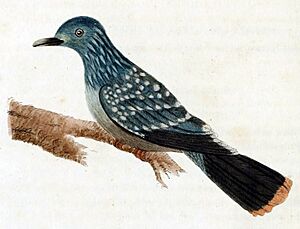
The English bird expert John Latham first wrote about the spotted green pigeon in 1783. He saw two specimens and a drawing. We don't know where these birds came from. One specimen ended up in the collection of Thomas Davies. The other was with the naturalist Joseph Banks. Banks got many specimens from the explorer James Cook. Davies got birds from New South Wales. This suggests the pigeon might have lived in the South Pacific Ocean. But there are no clear records of spotted green pigeons being sent from these places.
After Davies died, his specimen was bought by Edward Smith-Stanley, 13th Earl of Derby in 1812. It was kept at Knowsley Hall. In 1851, this collection moved to the Derby Museum. The specimen was then made into a study skin for scientific study. This museum later became the World Museum in Liverpool. The pigeon is still there today. Sadly, Banks' specimen is now lost. Latham also mentioned a drawing of the bird. It was in the collection of Ashton Lever. We don't know which bird this drawing was based on.
Latham included an illustration of the pigeon in his 1823 book. This drawing was different from Davies' specimen in some ways. It might have been based on the drawing from Lever's collection. Latham said that drawing showed the tail end as "deep ferruginous" (rust-colored). His own illustration also showed this.
Naming and Classifying the Pigeon
The German naturalist Johann Friedrich Gmelin gave the pigeon its scientific name in 1789. He based it on Latham's description. The original name, Columba maculata, means "spotted pigeon" in Latin. Latham himself accepted this name. Since Latham's 1783 description was based on Davies' specimen, that specimen is considered the main example of the species.

For a long time, scientists were unsure about this bird. Some thought it was a young Nicobar pigeon. Others thought it was a different species. In 1898, Henry Ogg Forbes said it was a real species. He placed it in the same genus as the Nicobar pigeon, Caloenas. In 1901, Walter Rothschild and Ernst Hartert agreed it belonged to Caloenas. But they thought it might be an "abnormality," even though more than one bird had been seen.
The spotted green pigeon was not often mentioned in books during the 1900s. Little new information came out. In 2001, Errol Fuller suggested it was overlooked because Rothschild thought it was just a strange bird. Fuller believed it was a real, extinct species. He also gave it a new common name: the Liverpool pigeon. Because of Fuller's work, BirdLife International listed the spotted green pigeon as "Extinct" in 2008. Before that, it wasn't even recognized.
In 2001, David Gibbs said the spotted green pigeon only looked a little like the Nicobar pigeon. He thought it might be different enough to have its own genus. He also guessed it might have lived on a Pacific island. This was based on stories from Tahitian islanders about a green and white speckled bird called titi. However, other scientists disagreed with this idea.
In 2020, Philippe Raust looked at old texts. He found that the information about the titi bird came from a missionary named John Muggridge Orsmond. He collected Tahitian traditions in the early 1800s. The book described the titi as "speckled green and white." It was mentioned with other pigeons. Raust thought this matched the spotted green pigeon. He also noted that the name titi was used for many birds whose calls sounded like "titi." Raust suggested that the study of these old texts supports the idea that the spotted green pigeon came from Tahiti. Finding bones of this bird on Tahiti could confirm this.
The only specimen is kept at the World Museum in Liverpool. It is stored very carefully to protect it. Researchers handle it with gloves. They limit its exposure to light.
How the Pigeon Evolved
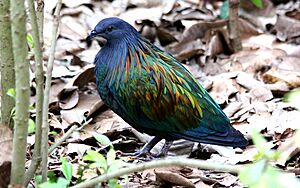
In 2014, scientists studied the ancient DNA of the spotted green pigeon. They compared its genes with other pigeons. They took samples from two of its feathers. The results showed that the spotted green pigeon was most closely related to the Nicobar pigeon. The genetic difference between them was like the difference between different species in the same genus. This proved they were distinct species in the same genus. It confirmed the spotted green pigeon was a unique, extinct bird.
|
|||||||||||||||||||||||||||||||||||||
The genus Caloenas (which includes the spotted green pigeon and Nicobar pigeon) was placed in a larger group. Most birds in this group had a mix of arboreal (tree-dwelling) and terrestrial (ground-dwelling) features. This might explain why scientists had so many different ideas about the relationships of these pigeons. There was a third species in the Caloenas genus, the Kanaka pigeon. We only know about it from old bones found in New Caledonia and Tonga. This pigeon was larger than the other two. So, it's unlikely to be the same as the spotted green pigeon. The genetic results also showed that the spotted green pigeon was not a hybrid (a mix of two different species).
The Nicobar pigeon and Kanaka pigeon could fly. Their distribution suggests that the spotted green pigeon might have come from Oceania or southeast Asia. The closest relatives of Caloenas were the extinct subfamily Raphinae. This group includes the dodo from Mauritius and the Rodrigues solitaire from Rodrigues. This suggests the spotted green pigeon could also have come from somewhere in the Indian Ocean. It seems most likely that this bird lived on an island, like its relatives. The fact that Caloenas pigeons are related to the ancestors of the dodo and Rodrigues solitaire means that the dodo's ancestors could fly. They reached the Mascarene Islands by flying from island to island from south Asia.
What the Pigeon Looked Like
Latham's 1823 description of the spotted green pigeon said it was about twelve inches long. Its bill was black with a pale yellow tip. The area around its eye was somewhat bare. The feathers were mostly dark green and shiny. Its head and neck were darker and plain. The neck feathers were long and narrow, like a rooster's. Most feathers on its wings had a pale white spot at their tips. Its flight feathers and tail were black. The tail feathers had a rust-colored white tip. Its belly, thighs, and vent were dusky black. Its legs were brown, and its shins were partly covered with soft feathers. Its claws were black.
Most old writings about the spotted green pigeon just repeated Latham's descriptions. Not much new information was added until 2001. The surviving specimen is 32 cm (12.6 in) long. But museum specimens can be stretched or squashed. So, this might not be its exact length when it was alive. Its weight was never recorded. The spotted green pigeon seems to have been smaller and thinner than the Nicobar pigeon. The Nicobar pigeon can reach 40 cm (15.7 in). The Kanaka pigeon was about 25% larger than the Nicobar pigeon.
The spotted green pigeon's tail is 126 mm (5 in) long, which is longer than the Nicobar pigeon's tail. But its head is smaller in comparison. Its bill is 20 mm (0.8 in). Its lower leg bone (tarsus) is 33 mm (1.3 in). The specimen's wings look short and round. They were described as 175 mm (6.9 in) long. But a museum expert found that five outer flight feathers were pulled out of each wing. So, the wings would have been about 50 mm (2 in) longer in life, around 225 mm (9 in) in total. This matches Latham's 1823 illustration, which shows a bird with longer wings.
The specimen's bill is black with a yellowish tip. The skin above the bill is also black. The area around its eyes is bare. The top of its head is sooty black. The rest of its head is mostly brownish-black. The feathers on its neck have a dark green shine. Some neck feathers have paler spots near their tips. Most feathers on its back and wings are dark brown or brownish-black with a dark green shine. Almost all these feathers have a triangular, yellowish-buff spot at their tips. The spots are almost whitish on some shoulder feathers. The underside of its wings is black. The breast is brownish-black with a faint green shine. The tail is blackish with a dark green shine. It has a narrow, cinnamon-colored band at the end.
The legs are small and thin. They have long toes and large claws. The Nicobar pigeon has shorter claws and longer lower leg bones. When examining the specimen, an expert noticed that the legs were put back on incorrectly. So, the short feathers on the legs would have been on the inner side of the upper leg in life.
The spotted green pigeon has sometimes been described as having a bump at the base of its bill. This is similar to the Nicobar pigeon. This idea seems to have started with Forbes, who had the bird drawn with this feature. But the actual specimen does not have a bump. Latham also did not mention or draw this feature. So, these drawings are probably wrong. The specimen's artificial eyes were removed. But red paint around one eye suggests it was meant to have red eyes. Latham's illustration also showed red eyes.
The triangular spots on the spotted green pigeon are not unique. Other pigeons like the spot-winged pigeon and speckled pigeon also have them. These spots happen when a pigment called melanin isn't fully deposited during feather growth. The yellow-buff spots are very worn. Less worn feathers have white tips. This means the yellow-buff ones might have been stained or were from a different stage of feathers. The white tips were fresher. The spotted green pigeon's feathers were very soft compared to other pigeons. This might be because its body feathers were long. Its neck feathers were not as long as the Nicobar pigeon's.
The spotted green pigeon's feathers look a bit like the Nicobar pigeon's. But they also look like those of the imperial pigeon genus Ducula. The metallic-green color is common in Ducula pigeons. Similar neck feathers can be seen in the goliath imperial pigeon. The Polynesian imperial pigeon has similar soft feathers. Young birds of this species and the Pacific imperial pigeon have different feathers until they moult (shed old feathers). So, it's possible that the dull, brownish-black underside of the spotted green pigeon specimen is the plumage of a young bird. Adult birds of similar species have brighter, shinier colors. Latham's illustration, which shows a brighter bird with paler undersides and whiter wing tips, might show an adult.
How the Pigeon Lived and Its Habitat
We don't have any records of how the spotted green pigeon behaved. But scientists have guessed based on its body features. Its delicate, partly feathered legs and long tail suggest it lived at least partly in trees. After realizing its wings were not short, an expert said the bird would not have lived on the ground. This is different from the related Nicobar pigeon.
The spotted green pigeon's body shape (longer tail, shorter legs, long flight feathers) was more like the pigeons of the genus Ducula. So, it might have lived similarly to those birds. It probably lived mostly in trees. It would have stayed in the thick canopy of forests. In contrast, the Nicobar pigeon mostly looks for food on the forest floor. The dark eyes of the Nicobar pigeon are common for birds that find food on the ground. But the colored bill and likely colored eyes of the spotted green pigeon are like those of fruit-eating pigeons. The spotted green pigeon's feet are also similar to those of pigeons that find food in trees. Its slender bill suggests it ate soft fruits.
Some scientists first thought the bird was not a strong flyer because its wings looked short. They thought it didn't move around much. But even with longer wings, it was likely a sedentary bird. This means it mostly stayed in one place. It probably preferred not to fly over open water. This is similar to species in Ducula. It might have lived in a small, remote island area. This could explain why we don't know where it came from. The fact that Polynesians thought the titi came from mountain gods suggests it lived in remote, high-altitude forests.
Why the Pigeon Disappeared
The spotted green pigeon is most likely extinct. It might have already been close to disappearing when Europeans first arrived in its home. The species may have vanished because of too much hunting. Also, new animals brought by humans might have eaten them. Scientists suggest the bird might have survived until the 1820s. Old accounts from the 1800s support the idea that the bird became extinct around that time.



